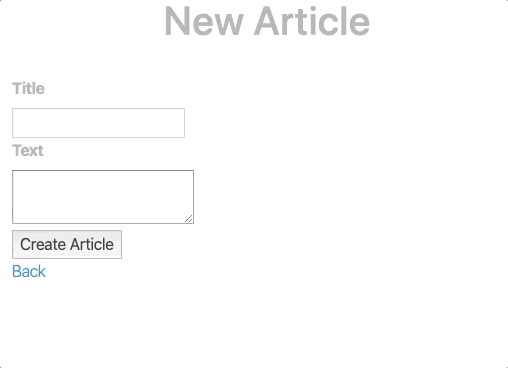Rails 5 and 6 Form Validation
Read on for a complete solution for integrating Rails server side model validations with client side browser HTML5 validations
Rails 5 and 6 server side ActiveRecord model validations under Turbolinks 5 are broken and do not automatically render the error messages to the user without a workaround.
This package contains a Stimulus controller for improved HTML 5 client side form validation error display.
It is useful in any environment and it plays well with the recommended Rails ActiveRecord model validation error display workaround documented below.
This stimulus controller works with or without Rails, with or without Turbolinks running, with or without data-remote Ajax form submission enabled, and falls back gracefully to the default browser HTML 5 form validations when Javascript is disabled.
-
It disables the HTML 5 validation system with the attribute
novalidate. This will still let us use the API, but it will stop showing native validation messages. -
It validates each field on blur events, and whole forms when they are submitted.
-
It prevents invalid forms from being submitted. This works with both Rails
data-remote="true"Ajax form submission and regular full page load form submission. -
It marks invalid fields with the class
.invalid. This allows us to integrate smoothly with server side validation errors. -
It shows native error messages by inserting a customizable error element with class
.errorafter each invalid input field. This matches the format for showing server side errors so the user sees a consistent feedback display.
Example
The new form validations look like this, first showing any client side validation messages until they are fixed, and then any server side validation messages.

Here is the example form using Rails form_with that links to the
form controller.
Configuration Settings
- invalid -
The invalid setting specifies the class that gets added to an input, select,
or textarea element containing an invalid value. It defaults to invalid
but can be set to any class name.
- error -
The error setting specifies the class of an error element that gets added
after an input element containing an invalid value.
It defaults to error but can be set to any class name.
Please fill out this field.
- template -
You can specify the error element that gets added after input elements containing an invalid value. Here is the default error element template.
{message}The controller will replace {error} with the error class name and
{message} with the field validation message(s).
The error element should include the error element class name so that the error message can be removed when the input is corrected.
- debug -
You can turn on console log debugging messages to see what is happening
during the field by field validation process.
To turn on logging set debug to 'true' or any value except
['false', 'f', 'off', '0', ''].
Per Form Configuration Examples
You can customize the configuration values both globally and per form.
Here is how to set the form configuration values from within Rails.
Here is a form configured with the default values in HTML to show configuration outside of Rails.
Client Side Validation Setup
Add rails-form-validation to package.json and register it with Stimulus.
You can set the application global defaults if you like or use the built in configuration values.
yarn add rails-form-validation
// Stimulus setup.const application = Applicationstart // Register the form controller.application // You can optionally set up application global defaults.FormIntegration with Rails 5 and 6 Server Side Validations
Server side validations are not properly supported under Rail 5 and 6. Turbolinks 6 is expected to address these issues.
I can confirm Turbolinks 6 will handle form submissions in a way that makes this unnecessary, among many other goodies
Check out this excellent article by Jorge Manrubia on Form validations with HTML5 and modern Rails
Rails Server Side Validation Setup
1. Add Jorge's turbolinks_render gem to the Gemfile.
2. Tag the form HTML with the server validation messages.
Add this file to config/initializers/form_errors.rb and set
the configuration values to match the client side settings.
# Insert model validation error messages after the input elements. # # Add this file to config/initializers/form_errors.rb # # You can configure these options here. config = { error: 'error', invalid: 'invalid', template: '<span class="{error}"><br>{message}</span>'} ActionView::Base.field_error_proc = Proc.new do |html_tag, instance_tag| # Find the invalid input element. fragment = Nokogiri::HTML.fragment(html_tag) field = fragment.at('input,select,textarea') if field # Get the configuration options. error = config[:error] invalid = config[:invalid] template = config[:template] # Add the input element invalid class. field['class'] = " " # Create the error message alert element. model = instance_tag.object field_name = instance_tag.instance_variable_get(:@method_name) field_title = field_name.titleize field_errors = model.errors[field_name] message = field_errors.map {|msg| " " }.join(', ') alert = template.gsub('{error}', error).gsub('{message}', message) # Append the alert to the invalid input element. html = " ".html_safe else # Return the element as is. html = html_tag end html.html_safe endThats it! You now have a unified browser and Rails model validation error display setup.